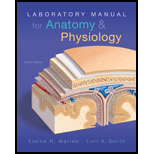
Laboratory Manual for Anatomy & Physiology (6th Edition) (Anatomy and Physiology)
6th Edition
ISBN: 9780134206332
Author: Elaine N. Marieb, Lori A. Smith
Publisher: PEARSON
expand_more
expand_more
format_list_bulleted
Textbook Question
Chapter 17, Problem 14SAQ
The refractory period of cardiac muscle is much longer than that of skeletal muscle. Why is this a desirable functional property?
Expert Solution & Answer
Want to see the full answer?
Check out a sample textbook solution
Students have asked these similar questions
The refractory period of cardiac muscle is much longer than that of skeletal muscle. Why is this a desirable functional property?
What is the significance of the extended refractory period in cardiac muscle?
Unlike skeletal muscle, cardiac muscle doesn’t undergo tetany. Explain how this is achieved and why is this necessary?
Chapter 17 Solutions
Laboratory Manual for Anatomy & Physiology (6th Edition) (Anatomy and Physiology)
Ch. 17.1 - The heart is in the mediastinum. Just what is the...Ch. 17.1 - From inside to outside, list the layers of the...Ch. 17.1 - What is the purpose of the serous fluid inside the...Ch. 17.2 - What is the function of the papillary muscles and...Ch. 17.2 - Prob. 5CYUCh. 17.3 - Which side of the heart acts as the pulmonary...Ch. 17.3 - Which of the following statements are true? (a)...Ch. 17.3 - Prob. 8CYUCh. 17.4 - For each of the following, state whether it...Ch. 17.5 - Cardiac muscle cannot go into tetany. Why?
Ch. 17.5 - Which part of the intrinsic conduction system...Ch. 17.5 - Describe the electrical event in the heart that...Ch. 17.5 - MAKING connections Below are drawings of three...Ch. 17.6 - The second heart sound is associated with the...Ch. 17.6 - If the mitral valve were insufficient, would you...Ch. 17.6 - During the cardiac cycle, there are two periods...Ch. 17.7 - Prob. 17CYUCh. 17.7 - What problem of cardiac output might ensue if the...Ch. 17 - When the semilunar valves are open, which of the...Ch. 17 - The portion of the intrinsic conduction system...Ch. 17 - An ECG provides information about (a) cardiac...Ch. 17 - The sequence of contraction of the heart chambers...Ch. 17 - The fact that the left ventricular wall is thicker...Ch. 17 - Prob. 6MCCh. 17 - In the heart, which of the following apply? (1)...Ch. 17 - The activity of the heart depends on intrinsic...Ch. 17 - Freshly oxygenated blood is first received by the...Ch. 17 - Describe the location and position of the heart in...Ch. 17 - Describe the pericardium and distinguish between...Ch. 17 - Trace one drop of blood from the time it enters...Ch. 17 - (a) Describe how heart contraction and relaxation...Ch. 17 - The refractory period of cardiac muscle is much...Ch. 17 - (a) Name the elements of the intrinsic conduction...Ch. 17 - Draw a normal ECG pattern. Label and explain the...Ch. 17 - Define cardiac cycle, and follow the events of one...Ch. 17 - What is cardiac output, and how is it calculated?Ch. 17 - Discuss how the Frank-Starling law of the heart...Ch. 17 - Prob. 1CCSCh. 17 - Prob. 2CCSCh. 17 - Prob. 3CCSCh. 17 - Prob. 4CCSCh. 17 - Prob. 5CCSCh. 17 - Prob. 6CCS
Knowledge Booster
Learn more about
Need a deep-dive on the concept behind this application? Look no further. Learn more about this topic, biology and related others by exploring similar questions and additional content below.Similar questions
- In a sheet of ventricular cardiac muscle tissue, we should be able to observe electricity spreading between adjacent muscle cells (TRUE or FALSE) and from Purkinje fibers to muscle cells (TRUE or FALSE) via electrical synapses that form between the cell membranes.arrow_forwardCardiac muscle is described as being under involuntary control. Why is it that some individuals can seemingly “control” theirheart rate through meditation?arrow_forwardFor cardiac muscle action potentials, describe ionmovement during the depolarization, early repolarization,plateau, and final repolarization phases.arrow_forward
- Below are drawings of three different action potentials. Two of these occur in the heart, and one occurs in skeletal muscle. Which one comes from a contractile cardiac muscle cell? A skeletal muscle cell? A cardiac pacemaker cell? For each one, state which ion is responsible for the depolarization phase and which ion is responsible for the repolarization phase.arrow_forwardWhy is the plateau phase important in cardiac muscle cells?arrow_forwardDraw a labeled cardiac muscle action potential.arrow_forward
- The contracting cells of the heart are a type of striated muscle that is said to work as a functional syncytium. Provide a definition for “functional syncytium” and describe important functional characteristics and cellular specializationsarrow_forwardCan cardiac muscle exhibit (normally or under experimental conditions) summation or complete tetanus as does skeletal muscle? Why not? (highlight the main concepts)arrow_forwardThe plasma membranes of adjacent cardiac muscle cells are connected via ____________, in which ____________ tie the cells together and ____________allow current (ions) to flow from one cell to the next (electrical coupling).arrow_forward
arrow_back_ios
SEE MORE QUESTIONS
arrow_forward_ios
Recommended textbooks for you
 Human Physiology: From Cells to Systems (MindTap ...BiologyISBN:9781285866932Author:Lauralee SherwoodPublisher:Cengage Learning
Human Physiology: From Cells to Systems (MindTap ...BiologyISBN:9781285866932Author:Lauralee SherwoodPublisher:Cengage Learning Anatomy & PhysiologyBiologyISBN:9781938168130Author:Kelly A. Young, James A. Wise, Peter DeSaix, Dean H. Kruse, Brandon Poe, Eddie Johnson, Jody E. Johnson, Oksana Korol, J. Gordon Betts, Mark WomblePublisher:OpenStax College
Anatomy & PhysiologyBiologyISBN:9781938168130Author:Kelly A. Young, James A. Wise, Peter DeSaix, Dean H. Kruse, Brandon Poe, Eddie Johnson, Jody E. Johnson, Oksana Korol, J. Gordon Betts, Mark WomblePublisher:OpenStax College

Human Physiology: From Cells to Systems (MindTap ...
Biology
ISBN:9781285866932
Author:Lauralee Sherwood
Publisher:Cengage Learning

Anatomy & Physiology
Biology
ISBN:9781938168130
Author:Kelly A. Young, James A. Wise, Peter DeSaix, Dean H. Kruse, Brandon Poe, Eddie Johnson, Jody E. Johnson, Oksana Korol, J. Gordon Betts, Mark Womble
Publisher:OpenStax College
The Cardiovascular System: An Overview; Author: Strong Medicine;https://www.youtube.com/watch?v=Wu18mpI_62s;License: Standard youtube license